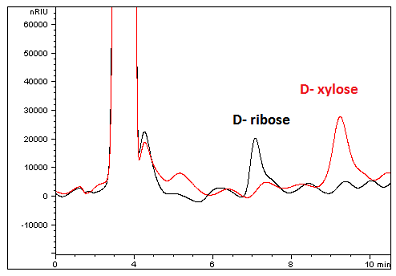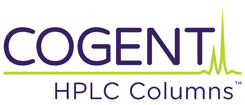Sugars can be difficult to analyze with HPLC due to their polarity. Columns with amine ligands are often used for retention of simple sugars like Ribose and Xylose, but they have a number of drawbacks. The amine group can form Schiff bases with Aldehydes in the sample, resulting in irreversible deactivation of the ligand’s retention functionality.
Poor robustness and column life have been reported for Amine columns for this reason. The Cogent Amide Column avoids this problem because its ligand is less chemically reactive than an amine, while still obtaining good retention and separation of the two sugar analytes.


Peaks:
1. D-Ribose
2. D-Xylose
Method Conditions:
Column: Cogent Amide™, 4 μm, 100 Å
Catalog No.: 40036-10P
Dimensions: 4.6 x 100mm
Mobile Phase: 95% Acetonitrile / 5% DI Water / 0.1% Triethylamine (TEA) (v/v)
Flow Rate: 0.5 mL / minute
Detection: Refractive Index
Injection Volume: 5ul
Sample Preparation: D-Ribose and D-Xylose reference standards (3 mg/mL) in diluent of 50% Acetonitrile / 50% DI Water / 0.1% TEA (v/v)
Note: Ribose and Xylose are aldopentoses that differ only by a chiral center. In addition to the open chain forms, these sugars exist in equilibrium with ring forms (five or six membered) as well as α and β anomers. Both sugars are highly polar and not generally suitable for conventional Reversed Phase retention.
Attachment
No 353 Ribose and Xylose.pdf 0.4 Mb Download File


